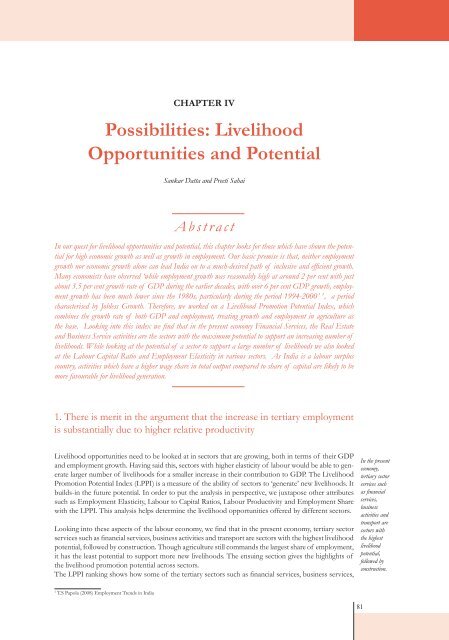SOIL Report 2008 - ACCESS Development Services
SOIL Report 2008 - ACCESS Development Services
SOIL Report 2008 - ACCESS Development Services
You also want an ePaper? Increase the reach of your titles
YUMPU automatically turns print PDFs into web optimized ePapers that Google loves.
Chapter IVPossibilities: LivelihoodOpportunities and PotentialSankar Datta and Preeti SahaiAbstractIn our quest for livelihood opportunities and potential, this chapter looks for those which have shown the potentialfor high economic growth as well as growth in employment. Our basic premise is that, neither employmentgrowth nor economic growth alone can lead India on to a much-desired path of inclusive and efficient growth.Many economists have observed ‘while employment growth was reasonably high at around 2 per cent with justabout 3.5 per cent growth rate of GDP during the earlier decades, with over 6 per cent GDP growth, employmentgrowth has been much lower since the 1980s, particularly during the period 1994-2000’ 1 , a periodcharacterised by Jobless Growth. Therefore, we worked on a Livelihood Promotion Potential Index, whichcombines the growth rate of both GDP and employment, treating growth and employment in agriculture asthe base. Looking into this index we find that in the present economy Financial <strong>Services</strong>, the Real Estateand Business Service activities are the sectors with the maximum potential to support an increasing number oflivelihoods. While looking at the potential of a sector to support a large number of livelihoods we also lookedat the Labour Capital Ratio and Employment Elasticity in various sectors. As India is a labour surpluscountry, activities which have a higher wage share in total output compared to share of capital are likely to bemore favourable for livelihood generation.1. There is merit in the argument that the increase in tertiary employmentis substantially due to higher relative productivityLivelihood opportunities need to be looked at in sectors that are growing, both in terms of their GDPand employment growth. Having said this, sectors with higher elasticity of labour would be able to generatelarger number of livelihoods for a smaller increase in their contribution to GDP. The LivelihoodPromotion Potential Index (LPPI) is a measure of the ability of sectors to ‘generate’ new livelihoods. Itbuilds-in the future potential. In order to put the analysis in perspective, we juxtapose other attributessuch as Employment Elasticity, Labour to Capital Ratios, Labour Productivity and Employment Sharewith the LPPI. This analysis helps determine the livelihood opportunities offered by different sectors.Looking into these aspects of the labour economy, we find that in the present economy, tertiary sectorservices such as financial services, business activities and transport are sectors with the highest livelihoodpotential, followed by construction. Though agriculture still commands the largest share of employment,it has the least potential to support more new livelihoods. The ensuing section gives the highlights ofthe livelihood promotion potential across sectors.The LPPI ranking shows how some of the tertiary sectors such as financial services, business services,In the presenteconomy,tertiary sectorservices suchas financialservices,businessactivities andtransport aresectors withthe highestlivelihoodpotential,followed byconstruction.1T.S Papola (<strong>2008</strong>) Employment Trends in India81














